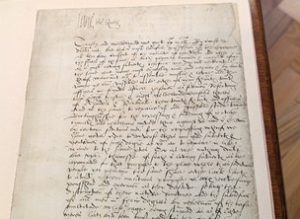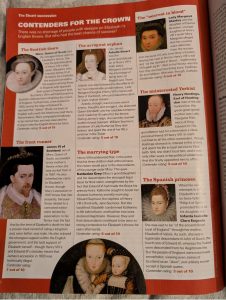Last month, Dr Stephan Edwards and I were incredibly lucky to view these documents relating to Lady Jane Grey at the Inner Temple Library, London.
Our grateful thanks to the Librarian and Keeper of the Manuscripts, Rob Hodgson, for this private visit to the library that we will never forget.
Devise for the Succession
[Petyt MS 538 vol. 47 f.317]
Written in his own handwriting, Edward VI drafted his ideas for who should succeed him. Originally the King left the throne to ‘L’ Jane’s heires masles’ but later changed this to ‘L’ Jane and her heires masles.’
 (c) Inner Temple Library
(c) Inner Temple Library
Original letter of Lady Jane Grey as Queen
18 July 1553
[Petyt MS 538 vol. 47 f.12]
 (c) Inner Temple Library
(c) Inner Temple Library
‘On the 18th July 1553 Lady Jane Grey wrote to Sir John St. Lowe and Sir Anthony Kingston, signing herself “Jane the Quene” and instructing them: “Our most lawful possession of the crown, with the free consent of the nobility of our Realm and the states of the same is both plainly known and accepted”. She requires them “to assemble, muster and levy all the power you can possibly make, either of your servants, tenants, officers or friends, as well horsemen as footmen, reserving to the Earls of Arundel and Pembroke their tenants servants and officers, and to repair with all possible speed towards Buckinghamshire, for the repressing and subduing of certain tumults and rebellions moved there against us and our crown, by certain seditious men”. (1)
Original Letter signed ‘Mary the Queene’
9 July 1553
[Petyt MS 538 vol. 47 f.13]
 (c) Inner Temple Library
(c) Inner Temple Library
‘Three days after Edward’s death, on the 9th July 1553, Mary sent this letter to Hastings from Kenninghall manor, Norfolk signing herself “Marye the Quene”. In the letter Mary announces the death of Edward “upon Thursday late at night”, by which the crown had come to her “by act of parliament and by the testament and last will of our late dearest father King Henry the Eighth”. She orders Hastings to secure “the surety of our person, the universal quietness of the whole realm, specially that of our counties of Middlesex and Bucks”.’ (2)
Sources
1.‘Booklet of the Treasures’, Inner Temple Library & Archives Grand Day Treasures (November 2024), p.4. URL: https://www.innertemplelibrary.org.uk/wp-content/uploads/2024/11/Booklet-of-the-Treasures.pdf Date accessed: 10 August 2025.
2.Booklet of the Treasures’, Inner Temple Library & Archives Grand Day Treasures (November 2024), p.3. URL: https://www.innertemplelibrary.org.uk/wp-content/uploads/2024/11/Booklet-of-the-Treasures.pdf Date accessed: 10 August 2025.








































